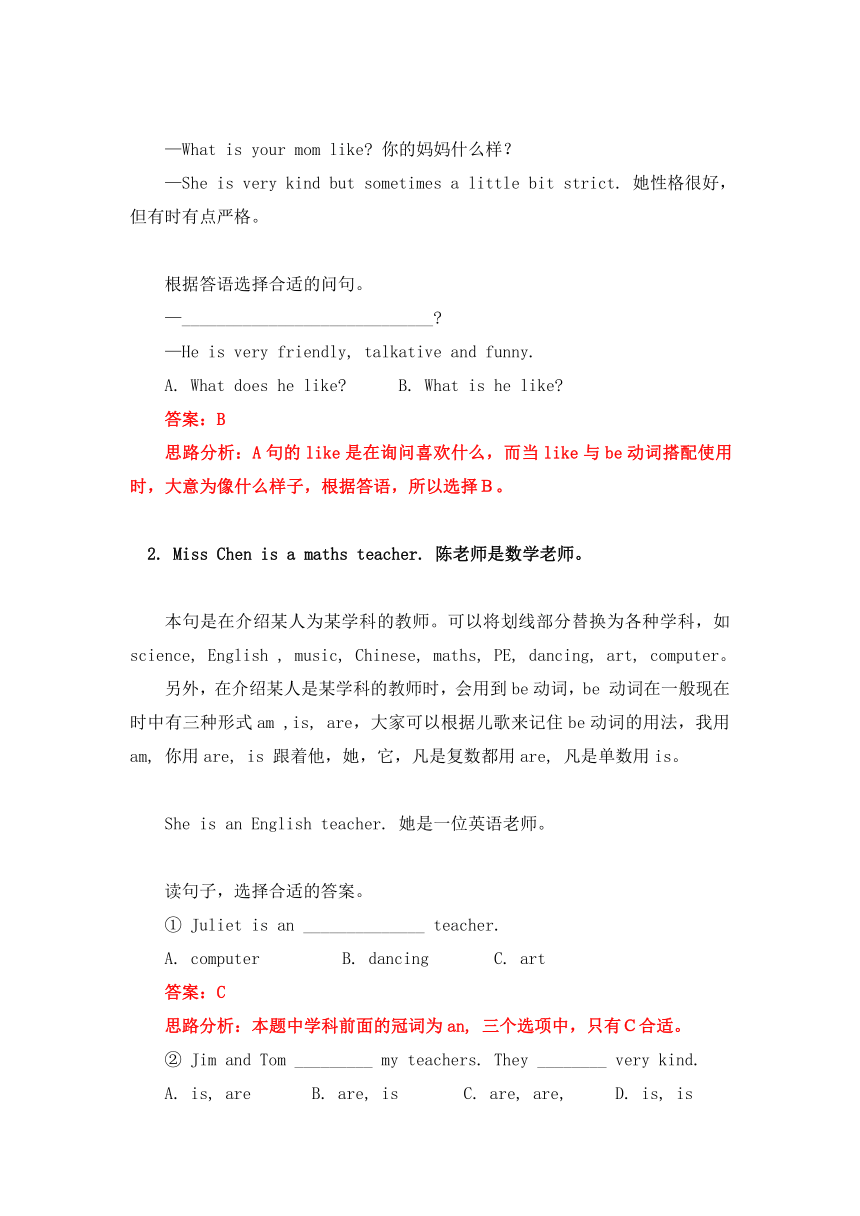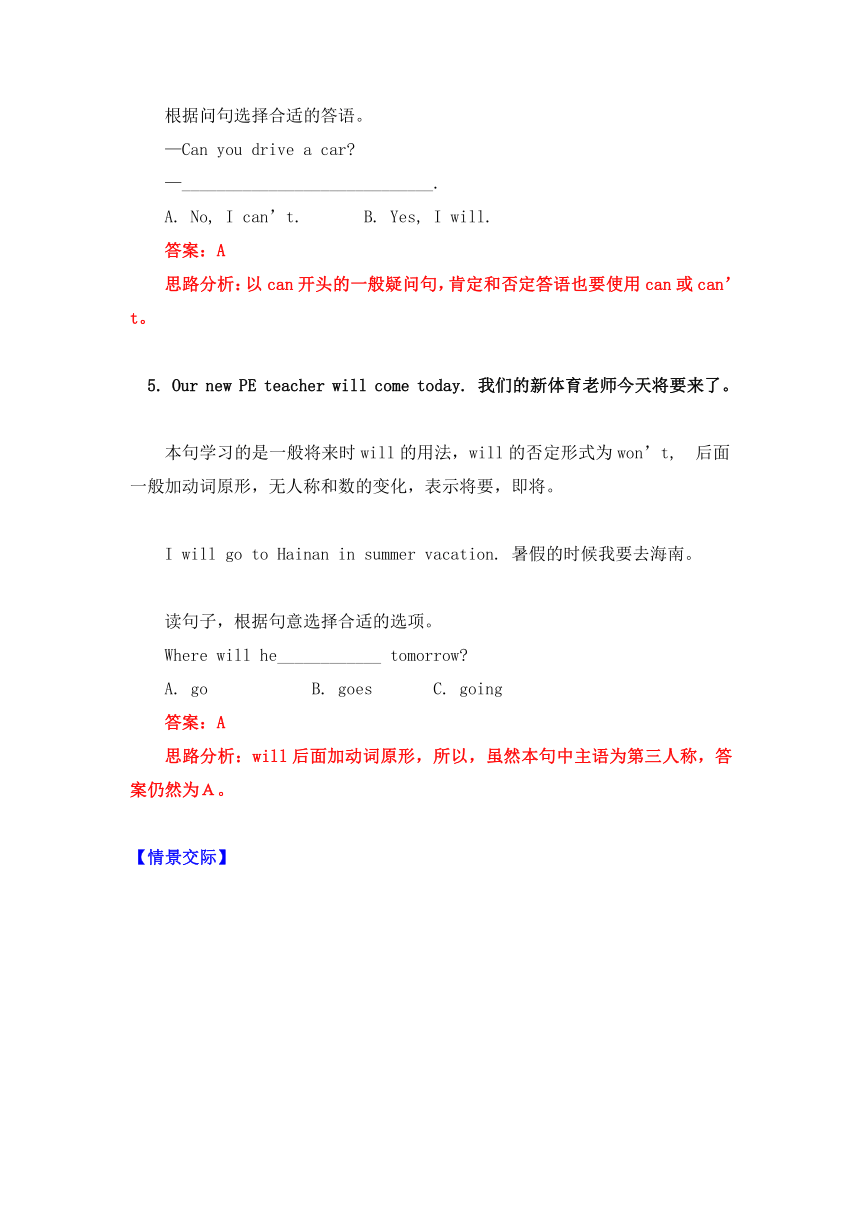Unit 1 What’s he like Section B~Section C 导学案(含答案)
文档属性
| 名称 | Unit 1 What’s he like Section B~Section C 导学案(含答案) |  | |
| 格式 | doc | ||
| 文件大小 | 133.0KB | ||
| 资源类型 | 教案 | ||
| 版本资源 | 人教版(PEP) | ||
| 科目 | 英语 | ||
| 更新时间 | 2020-08-28 00:19:05 | ||
图片预览





文档简介
小学英语 说一说(Unit 1 What’s he like(Section B~Section C))
学习目标:
1. 能够用恰当的语气朗读对话内容,理解Story time部分的短文。
2. 能够自如地替换使用本单元的功能句型,并在交流中运用。
3. 能够理解情态动词can, must, be动词以及一般将来时will等词的用法,并在句子中使用。
重点:学习本单元的功能句,并进行替换练习。
学习情态动词和be动词用法,以及一般将来时的用法。
难点:学习情态动词和be动词以及一般将来时的用法
知识梳理:
【课文朗读】
Chen Jie: Hey, Ms Wang will be our new Chinese teacher.
John: Really? What’s she like?
Chen Jie: She’s kind.
John: Is she strict?
Chen Jie: Yes, sometimes.
John: Do you know her?
Chen Jie: Yes. She’s my mother!
John: Haha, cool!
【句子赏析】
1. What’s she like? 她什么样?
本句是询问某人的性格、个性。
—What is your mom like? 你的妈妈什么样?
—She is very kind but sometimes a little bit strict. 她性格很好,但有时有点严格。
根据答语选择合适的问句。
—_____________________________?
—He is very friendly, talkative and funny.
A. What does he like? B. What is he like?
答案:B
思路分析:A句的like是在询问喜欢什么,而当like与be动词搭配使用时,大意为像什么样子,根据答语,所以选择B。
2. Miss Chen is a maths teacher. 陈老师是数学老师。
本句是在介绍某人为某学科的教师。可以将划线部分替换为各种学科,如science, English , music, Chinese, maths, PE, dancing, art, computer。
另外,在介绍某人是某学科的教师时,会用到be动词,be 动词在一般现在时中有三种形式am ,is, are,大家可以根据儿歌来记住be动词的用法,我用am, 你用are, is 跟着他,她,它,凡是复数都用are, 凡是单数用is。
She is an English teacher. 她是一位英语老师。
读句子,选择合适的答案。
① Juliet is an ______________ teacher.
A. computer B. dancing C. art
答案:C
思路分析:本题中学科前面的冠词为an, 三个选项中,只有C合适。
② Jim and Tom _________ my teachers. They ________ very kind.
A. is, are B. are, is C. are, are, D. is, is
答案:C
思路分析:Jim and Tom是两个人作主语,应该是复数;they是他们的意思,也应该用复数are。
3. He must be tall and strong. 他肯定又高又壮。
本句学习的是情态动词must的用法,本词有多种含义,但是在这里表示推测:必定,一定,后面一定要加动词原形,无人称和数的变化形式。
注意:must表示推测时的否定式是can’t或couldn’t(不可能),因为must只用于肯定句,语气很强。
The light is still on, so he must be at home. 灯还开着,所以他一定在家。
读句子,根据句意选择合适的选项。
The man drives a very expensive car. He __________ be very rich.
A. can B. must C. will
答案:B
思路分析:本题大意,这个男人开着一辆非常昂贵的车,他肯定很有钱。从前一句中推测出的答案,所以答案是B。
4. Can you play football? 你会踢足球吗?
can 是情态动词,后面必须加动词原形,无人称和数的变化,否定形式为can’t, 可以表示请求或允许,意为可以,能;也可以表示能力,能够,会。在这里的意思为后者。
—Can you sing? 你会唱歌吗?
—Of course I can. 当然会。
根据问句选择合适的答语。
—Can you drive a car?
—_____________________________.
A. No, I can’t. B. Yes, I will.
答案:A
思路分析:以can开头的一般疑问句,肯定和否定答语也要使用can或can’t。
5. Our new PE teacher will come today. 我们的新体育老师今天将要来了。
本句学习的是一般将来时will的用法,will的否定形式为won’t, 后面一般加动词原形,无人称和数的变化,表示将要,即将。
I will go to Hainan in summer vacation. 暑假的时候我要去海南。
读句子,根据句意选择合适的选项。
Where will he____________ tomorrow?
A. go B. goes C. going
答案:A
思路分析:will后面加动词原形,所以,虽然本句中主语为第三人称,答案仍然为A。
【情景交际】
在英美国家中,打招呼时,应避免中式用语“你上哪儿去”、“你干什么去”等,在西方人看来,有涉人私事之嫌,是失礼的语言;更不应说“吃饭了吗”,否则会被误认为你想邀请他一起吃饭。最常见的打招呼用语为“您好”。
“您好”的表达方式有:
1. Hi!/ Hello! 你好!
2. How do you do? 您好。(初次见面,用于非常正式的场合)
3. How are you? 你好!
4. How are you today? 你今天好吗?
5. How is everything? 一切都好吗?
6. How is everything with you going? 你一切都好吗?
7. How have you been? 你最近怎么样?(当有段时间没见面时用)
8. What’s up? 有什么新鲜事吗?(比较随意的用法)
当Richard 遇到了朋友Dan, 并把自己的堂妹介绍了他。
Richard: 1 , Dan?
Dan: Fine! How are you?
Richard: Great. This is my cousin, Claire. Claire, this is my classmate, Dan.
Claire: 2 , Dan.
Dan: Pleased to meet you. I will go to play tennis. 3 ?
Richard: Yes, my cousin can play very well.
Dan: Good. Would you like to go together?
Claire: 4 .
A: Can you play tennis
B: Hello
C: How are you
D: Ok. Let’s go
答案:C B A D
思路分析:1. 从第一句的答语可以判断出此处为问好的句子,而且是个问句,虽然hello也是在问好,但是它的答语不应是fine. 所以答案为C。
2. 两个人被介绍过后在正式打招呼。所以答案为B。
3. 从答语中可以判断出为一般疑问句,而且是在问对方会不会打网球。所以答案为A。
4. 在他人发出邀请后,做出的回应,所以答案为D。
即学即练:
一、请根据不同人称填写不同的be动词。
(1)I _____ a student.
(2)The girl______ Jack’s sister.
(3)He _____ a good boy.
(4)Who ______ I?
(5)They _____ playing?
二、请用动词的适当形式填空。
( ) 1. We __________ a meeting tomorrow afternoon.
A. will having B. will going to have
C. is gong to D. will have
( ) 2. Charlie ________ here next month.
A. isn’t working B. doesn’t working
C. isn’t going to working D. won’t work
( ) 3. He ________ very busy this week, he ________ free next week.
A. will be; is B. is; is
C. will be; will be D. is; will be
( ) 4. —________ you ________ free tomorrow?
—No. I ________ free the day after tomorrow.
A. Are; going to; will B. Are; going to be; will
C. Are; going to; will be D. Are; going to be; will be
( ) 5. Mother ________ me a nice present on my next birthday.
A. will gives B. will give C. gives D. give
答案:一、1. am 2. is 3.is 4. am 5. are
思路分析:第一个空,I为第一人称,应搭配am。
第二和三小题的主语the girl, he都是第三人称单数作主语,所以答案为is。
第五小题主语they的意思为他们,是复数形式,因此答案为are。
二、1. D 2. D 3. D 4. D 5. B
思路分析:第一小题,从时间标志明天下午可以得知应该用一般将来时,will后面加动词原形,所以答案是D。
第二小题,从下个月的时间可以得知本句为一般将来时态,won’t 后面应该加动词原形。
第三小题,从前半句中的这个星期,我们知道应该是一般现在时,后半句的时间标志是下个星期,应该是一般将来时,所以答案是D。
第四小题,从时间上判断,tomorrow和the day after tomorrow,明天和后天,都是将来时的标志,因此问答句都应该使用将来时,free是形容词,前面要有be动词,因此问句中可以用be going to +动词原形be, 答语中使用will+be。
第五小题,从next birthday下个生日得出,本句应该使用将来时,所以答案为B。
同步练习:
(答题时间:20分钟)
一、连线。请将下列句子与其相应的中文意思连接起来。
What is he like? 你会唱英文歌吗?
He is our PE teacher. 他什么样?
Let’s go to playground. 我们体育老师肯定特别高大强壮。
Can you sing an English song? 我们一起去操场吧!
Our PE teacher must be very tall and strong. 他是我们的体育老师。
二、根据所给句子,选出下列各句的问句或答语,将答案的标号写在题前括号里。
( )1. —What is he like?
—____________________.
( )2. —Who is he ?
—____________________.
( )3. —____________________?
—Yes, of course.
( )4. —_____________________.
—Let’s go.
( )5. —I heard that our new P.E. teacher is a very good football player.
—___________________________.
A. He is our P.E. teacher
B. Let’s go to playground
C. Can you sing an English song
D. Our P.E. teacher must be very tall and strong
E. He is very funny
三、根据短文内容给图片排序。用数字1、2、3、4、5表示。
Today is a school day, now it’s 7:00, but Allen is still(仍然) on the bed. Look, Allen is crying now, because he is late for school. After school, Allen plays a long time outside, so he is late at the dinner time. Allen wants to go to his grandpa’s house by the train, but he is late again. Allen doesn’t want to be late again, so next day he goes to school before 8:00. Allen will never be late again, he is so happy now.
( ) ( ) ( ) ( ) ( )
答案:
一、
二、
1. E 解析:问句的意思是“他是什么样的人?”回答是E项“他很有趣。”
2. A 解析:问句的意思是“他是谁?”回答是A项“他是我们的体育老师。”
3. C 解析:根据答句“是的,当然。”可知,问句应该是问“你会……吗?”
4. B 解析:根据后句“我们走吧。”可知,前句是是说“让我们……”。
5. D 解析:根据前句的内容可知,后句应该是对“我们的体育老师”的样子的猜测。
三、1,5,3,4,2
解析:在读故事前,先看五幅图片,观察图片里的 人物和情景,每一幅图在原文中都能找到答案。边阅读边针对图片,在原文中进行标注。
Today is a school day, now①it’s 7:00, but Allen is still(仍然) on the bed. ②Look, Allen is crying now, because he is late for school. After school, Allen plays a long time outside, ③so he is late at the dinner time. ④Allen wants to go to his grandpa’s house by the train, but he is late again. Allen doesn’t want to be late again, ⑤so next day he goes to school before 8:00. Allen will never be late again, he is so happy now.
学习目标:
1. 能够用恰当的语气朗读对话内容,理解Story time部分的短文。
2. 能够自如地替换使用本单元的功能句型,并在交流中运用。
3. 能够理解情态动词can, must, be动词以及一般将来时will等词的用法,并在句子中使用。
重点:学习本单元的功能句,并进行替换练习。
学习情态动词和be动词用法,以及一般将来时的用法。
难点:学习情态动词和be动词以及一般将来时的用法
知识梳理:
【课文朗读】
Chen Jie: Hey, Ms Wang will be our new Chinese teacher.
John: Really? What’s she like?
Chen Jie: She’s kind.
John: Is she strict?
Chen Jie: Yes, sometimes.
John: Do you know her?
Chen Jie: Yes. She’s my mother!
John: Haha, cool!
【句子赏析】
1. What’s she like? 她什么样?
本句是询问某人的性格、个性。
—What is your mom like? 你的妈妈什么样?
—She is very kind but sometimes a little bit strict. 她性格很好,但有时有点严格。
根据答语选择合适的问句。
—_____________________________?
—He is very friendly, talkative and funny.
A. What does he like? B. What is he like?
答案:B
思路分析:A句的like是在询问喜欢什么,而当like与be动词搭配使用时,大意为像什么样子,根据答语,所以选择B。
2. Miss Chen is a maths teacher. 陈老师是数学老师。
本句是在介绍某人为某学科的教师。可以将划线部分替换为各种学科,如science, English , music, Chinese, maths, PE, dancing, art, computer。
另外,在介绍某人是某学科的教师时,会用到be动词,be 动词在一般现在时中有三种形式am ,is, are,大家可以根据儿歌来记住be动词的用法,我用am, 你用are, is 跟着他,她,它,凡是复数都用are, 凡是单数用is。
She is an English teacher. 她是一位英语老师。
读句子,选择合适的答案。
① Juliet is an ______________ teacher.
A. computer B. dancing C. art
答案:C
思路分析:本题中学科前面的冠词为an, 三个选项中,只有C合适。
② Jim and Tom _________ my teachers. They ________ very kind.
A. is, are B. are, is C. are, are, D. is, is
答案:C
思路分析:Jim and Tom是两个人作主语,应该是复数;they是他们的意思,也应该用复数are。
3. He must be tall and strong. 他肯定又高又壮。
本句学习的是情态动词must的用法,本词有多种含义,但是在这里表示推测:必定,一定,后面一定要加动词原形,无人称和数的变化形式。
注意:must表示推测时的否定式是can’t或couldn’t(不可能),因为must只用于肯定句,语气很强。
The light is still on, so he must be at home. 灯还开着,所以他一定在家。
读句子,根据句意选择合适的选项。
The man drives a very expensive car. He __________ be very rich.
A. can B. must C. will
答案:B
思路分析:本题大意,这个男人开着一辆非常昂贵的车,他肯定很有钱。从前一句中推测出的答案,所以答案是B。
4. Can you play football? 你会踢足球吗?
can 是情态动词,后面必须加动词原形,无人称和数的变化,否定形式为can’t, 可以表示请求或允许,意为可以,能;也可以表示能力,能够,会。在这里的意思为后者。
—Can you sing? 你会唱歌吗?
—Of course I can. 当然会。
根据问句选择合适的答语。
—Can you drive a car?
—_____________________________.
A. No, I can’t. B. Yes, I will.
答案:A
思路分析:以can开头的一般疑问句,肯定和否定答语也要使用can或can’t。
5. Our new PE teacher will come today. 我们的新体育老师今天将要来了。
本句学习的是一般将来时will的用法,will的否定形式为won’t, 后面一般加动词原形,无人称和数的变化,表示将要,即将。
I will go to Hainan in summer vacation. 暑假的时候我要去海南。
读句子,根据句意选择合适的选项。
Where will he____________ tomorrow?
A. go B. goes C. going
答案:A
思路分析:will后面加动词原形,所以,虽然本句中主语为第三人称,答案仍然为A。
【情景交际】
在英美国家中,打招呼时,应避免中式用语“你上哪儿去”、“你干什么去”等,在西方人看来,有涉人私事之嫌,是失礼的语言;更不应说“吃饭了吗”,否则会被误认为你想邀请他一起吃饭。最常见的打招呼用语为“您好”。
“您好”的表达方式有:
1. Hi!/ Hello! 你好!
2. How do you do? 您好。(初次见面,用于非常正式的场合)
3. How are you? 你好!
4. How are you today? 你今天好吗?
5. How is everything? 一切都好吗?
6. How is everything with you going? 你一切都好吗?
7. How have you been? 你最近怎么样?(当有段时间没见面时用)
8. What’s up? 有什么新鲜事吗?(比较随意的用法)
当Richard 遇到了朋友Dan, 并把自己的堂妹介绍了他。
Richard: 1 , Dan?
Dan: Fine! How are you?
Richard: Great. This is my cousin, Claire. Claire, this is my classmate, Dan.
Claire: 2 , Dan.
Dan: Pleased to meet you. I will go to play tennis. 3 ?
Richard: Yes, my cousin can play very well.
Dan: Good. Would you like to go together?
Claire: 4 .
A: Can you play tennis
B: Hello
C: How are you
D: Ok. Let’s go
答案:C B A D
思路分析:1. 从第一句的答语可以判断出此处为问好的句子,而且是个问句,虽然hello也是在问好,但是它的答语不应是fine. 所以答案为C。
2. 两个人被介绍过后在正式打招呼。所以答案为B。
3. 从答语中可以判断出为一般疑问句,而且是在问对方会不会打网球。所以答案为A。
4. 在他人发出邀请后,做出的回应,所以答案为D。
即学即练:
一、请根据不同人称填写不同的be动词。
(1)I _____ a student.
(2)The girl______ Jack’s sister.
(3)He _____ a good boy.
(4)Who ______ I?
(5)They _____ playing?
二、请用动词的适当形式填空。
( ) 1. We __________ a meeting tomorrow afternoon.
A. will having B. will going to have
C. is gong to D. will have
( ) 2. Charlie ________ here next month.
A. isn’t working B. doesn’t working
C. isn’t going to working D. won’t work
( ) 3. He ________ very busy this week, he ________ free next week.
A. will be; is B. is; is
C. will be; will be D. is; will be
( ) 4. —________ you ________ free tomorrow?
—No. I ________ free the day after tomorrow.
A. Are; going to; will B. Are; going to be; will
C. Are; going to; will be D. Are; going to be; will be
( ) 5. Mother ________ me a nice present on my next birthday.
A. will gives B. will give C. gives D. give
答案:一、1. am 2. is 3.is 4. am 5. are
思路分析:第一个空,I为第一人称,应搭配am。
第二和三小题的主语the girl, he都是第三人称单数作主语,所以答案为is。
第五小题主语they的意思为他们,是复数形式,因此答案为are。
二、1. D 2. D 3. D 4. D 5. B
思路分析:第一小题,从时间标志明天下午可以得知应该用一般将来时,will后面加动词原形,所以答案是D。
第二小题,从下个月的时间可以得知本句为一般将来时态,won’t 后面应该加动词原形。
第三小题,从前半句中的这个星期,我们知道应该是一般现在时,后半句的时间标志是下个星期,应该是一般将来时,所以答案是D。
第四小题,从时间上判断,tomorrow和the day after tomorrow,明天和后天,都是将来时的标志,因此问答句都应该使用将来时,free是形容词,前面要有be动词,因此问句中可以用be going to +动词原形be, 答语中使用will+be。
第五小题,从next birthday下个生日得出,本句应该使用将来时,所以答案为B。
同步练习:
(答题时间:20分钟)
一、连线。请将下列句子与其相应的中文意思连接起来。
What is he like? 你会唱英文歌吗?
He is our PE teacher. 他什么样?
Let’s go to playground. 我们体育老师肯定特别高大强壮。
Can you sing an English song? 我们一起去操场吧!
Our PE teacher must be very tall and strong. 他是我们的体育老师。
二、根据所给句子,选出下列各句的问句或答语,将答案的标号写在题前括号里。
( )1. —What is he like?
—____________________.
( )2. —Who is he ?
—____________________.
( )3. —____________________?
—Yes, of course.
( )4. —_____________________.
—Let’s go.
( )5. —I heard that our new P.E. teacher is a very good football player.
—___________________________.
A. He is our P.E. teacher
B. Let’s go to playground
C. Can you sing an English song
D. Our P.E. teacher must be very tall and strong
E. He is very funny
三、根据短文内容给图片排序。用数字1、2、3、4、5表示。
Today is a school day, now it’s 7:00, but Allen is still(仍然) on the bed. Look, Allen is crying now, because he is late for school. After school, Allen plays a long time outside, so he is late at the dinner time. Allen wants to go to his grandpa’s house by the train, but he is late again. Allen doesn’t want to be late again, so next day he goes to school before 8:00. Allen will never be late again, he is so happy now.
( ) ( ) ( ) ( ) ( )
答案:
一、
二、
1. E 解析:问句的意思是“他是什么样的人?”回答是E项“他很有趣。”
2. A 解析:问句的意思是“他是谁?”回答是A项“他是我们的体育老师。”
3. C 解析:根据答句“是的,当然。”可知,问句应该是问“你会……吗?”
4. B 解析:根据后句“我们走吧。”可知,前句是是说“让我们……”。
5. D 解析:根据前句的内容可知,后句应该是对“我们的体育老师”的样子的猜测。
三、1,5,3,4,2
解析:在读故事前,先看五幅图片,观察图片里的 人物和情景,每一幅图在原文中都能找到答案。边阅读边针对图片,在原文中进行标注。
Today is a school day, now①it’s 7:00, but Allen is still(仍然) on the bed. ②Look, Allen is crying now, because he is late for school. After school, Allen plays a long time outside, ③so he is late at the dinner time. ④Allen wants to go to his grandpa’s house by the train, but he is late again. Allen doesn’t want to be late again, ⑤so next day he goes to school before 8:00. Allen will never be late again, he is so happy now.
